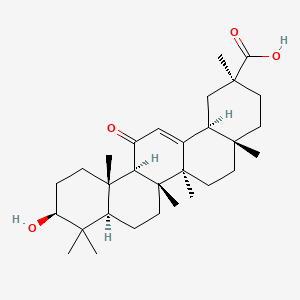| Authors | Title | Published | Journal | PubMed Link |
|---|---|---|---|---|
| Cavone L et al. | 18β-glycyrrhetic acid inhibits immune activation triggered by HMGB1, a pro-inflammatory protein found in the tear fluid during conjunctivitis and blepharitis. | 2011 | Ocul. Immunol. Inflamm. | pmid:21426233 |
| Sun W et al. | Design, synthesis, and sustained-release property of 1,3-cyclic propanyl phosphate ester of 18β-glycyrrhetinic acid. | 2011 | Chem Biol Drug Des | pmid:21244638 |
| Piao H et al. | Effects of connexin-mimetic peptides on perfusion pressure in response to phenylephrine in isolated, perfused rat kidneys. | 2011 | Clin. Exp. Nephrol. | pmid:21153751 |
| Ma KT et al. | [18β-glycyrrhetinic acid inhibits outward current of vascular smooth muscle cells of arterioles]. | 2011 | Sheng Li Xue Bao | pmid:22193450 |
| Ukil A et al. | Curative effect of 18β-glycyrrhetinic acid in experimental visceral leishmaniasis depends on phosphatase-dependent modulation of cellular MAP kinases. | 2011 | PLoS ONE | pmid:22194991 |
| Yu J et al. | Disruption of gap junctions reduces biomarkers of decidualization and angiogenesis and increases inflammatory mediators in human endometrial stromal cell cultures. | 2011 | Mol. Cell. Endocrinol. | pmid:21767601 |
| Autsavapromporn N et al. | Intercellular communication amplifies stressful effects in high-charge, high-energy (HZE) particle-irradiated human cells. | 2011 | J. Radiat. Res. | pmid:21905305 |
| Tabuchi M et al. | The blood-brain barrier permeability of 18β-glycyrrhetinic acid, a major metabolite of glycyrrhizin in Glycyrrhiza root, a constituent of the traditional Japanese medicine yokukansan. | 2012 | Cell. Mol. Neurobiol. | pmid:22488528 |
| Puchner A et al. | Effects of 18β-Glycyrrhetinic acid in hTNFtg mice - a model of rheumatoid arthritis. | 2012 | Wien. Klin. Wochenschr. | pmid:22210441 |
| Moon MH et al. | 18β-Glycyrrhetinic acid inhibits adipogenic differentiation and stimulates lipolysis. | 2012 | Biochem. Biophys. Res. Commun. | pmid:22465130 |
18alpha-glycyrrhetinic acid
18alpha-glycyrrhetinic acid is a lipid of Prenol Lipids (PR) class. 18alpha-glycyrrhetinic acid is associated with abnormalities such as Wiskott-Aldrich Syndrome. The involved functions are known as inhibitors, salivary gland development and branching morphogenesis.
Cross Reference
Introduction
To understand associated biological information of 18alpha-glycyrrhetinic acid, we collected biological information of abnormalities, associated pathways, cellular/molecular locations, biological functions, related genes/proteins, lipids and common seen animal/experimental models with organized paragraphs from literatures.
What diseases are associated with 18alpha-glycyrrhetinic acid?
18alpha-glycyrrhetinic acid is suspected in and other diseases in descending order of the highest number of associated sentences.
Related references are mostly published in these journals:
| Disease | Cross reference | Weighted score | Related literature |
|---|
No disease MeSH terms mapped to the current reference collection.
PubChem Associated disorders and diseases
What pathways are associated with 18alpha-glycyrrhetinic acid
There are no associated biomedical information in the current reference collection.
PubChem Biomolecular Interactions and Pathways
Link to PubChem Biomolecular Interactions and PathwaysWhat cellular locations are associated with 18alpha-glycyrrhetinic acid?
There are no associated biomedical information in the current reference collection.
What functions are associated with 18alpha-glycyrrhetinic acid?
Related references are published most in these journals:
| Function | Cross reference | Weighted score | Related literatures |
|---|
What lipids are associated with 18alpha-glycyrrhetinic acid?
There are no associated biomedical information in the current reference collection.
What genes are associated with 18alpha-glycyrrhetinic acid?
There are no associated biomedical information in the current reference collection.
What common seen animal models are associated with 18alpha-glycyrrhetinic acid?
There are no associated biomedical information in the current reference collection.
